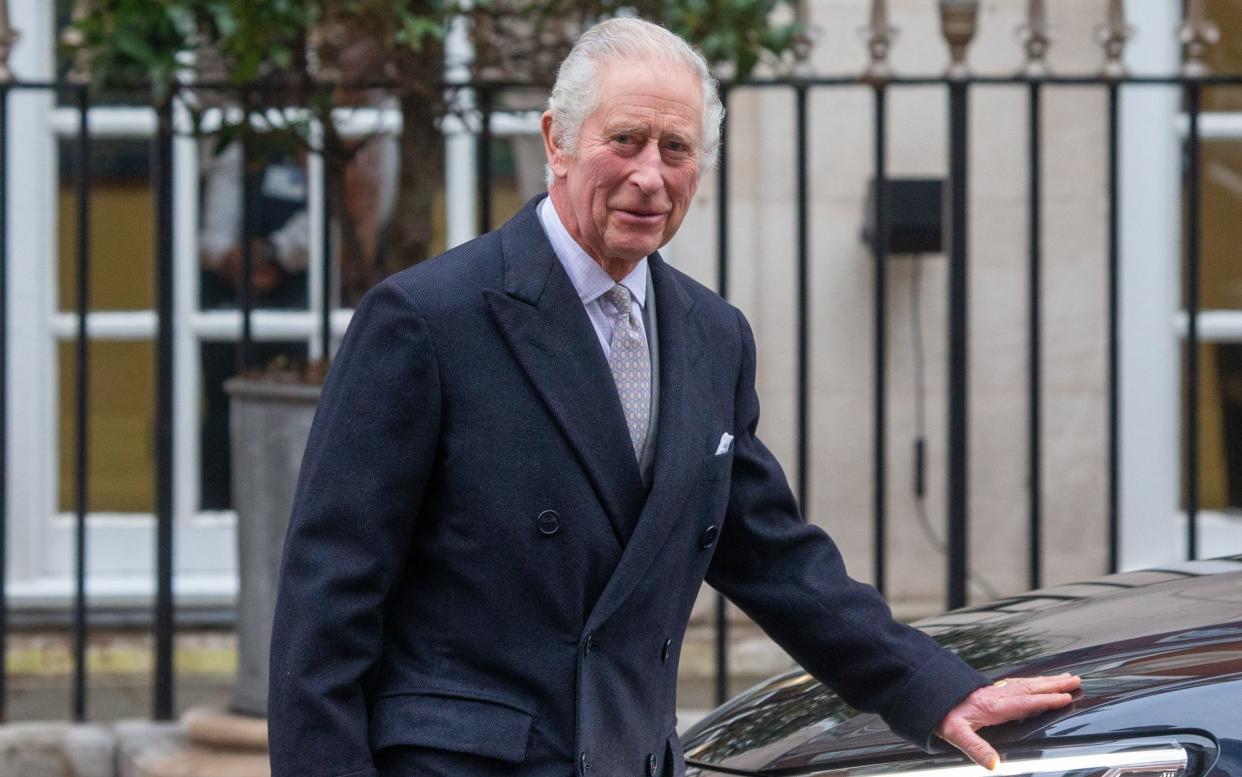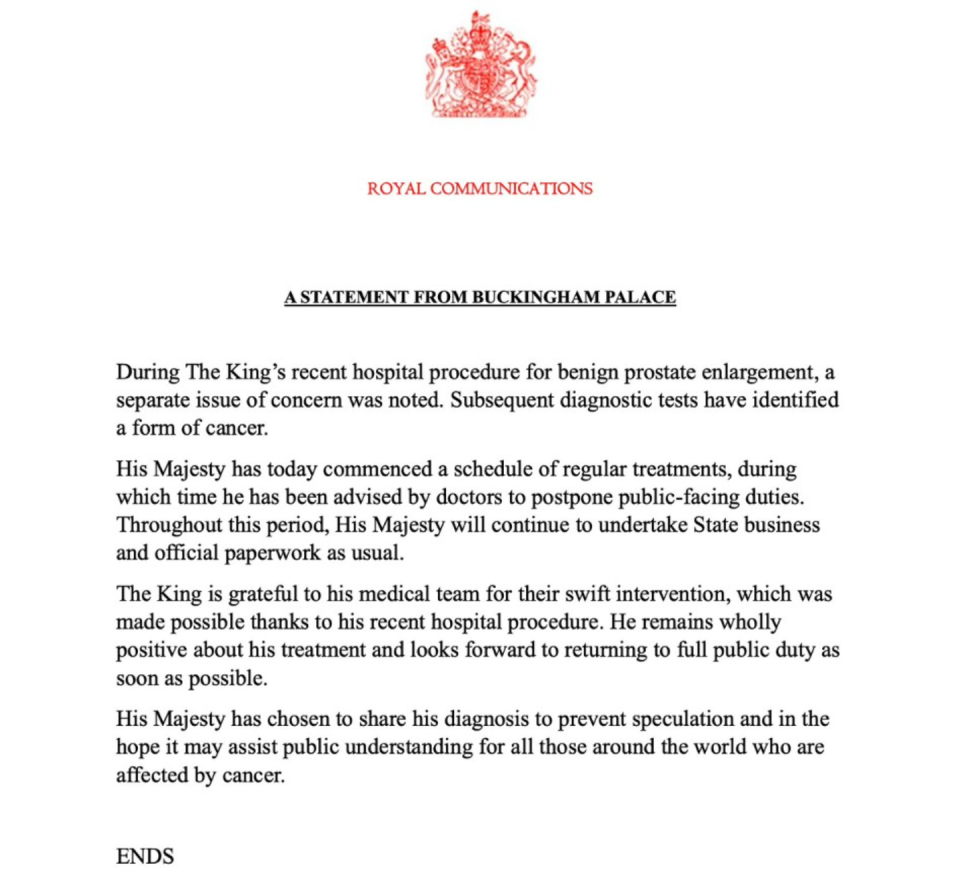The King’s diagnosis: What kind of cancer does he have?

The King has not revealed the type of cancer with which he has been diagnosed, but it was discovered after he received treatment for a benign prostate enlargement.
A Buckingham Palace spokesman said that it was during this corrective surgery that “a separate issue of concern was noted and subsequently diagnosed as a form of cancer”.
The risk of developing cancer increases with age and more people receive a diagnosis during their 70s than in any other decade.
Prostate cancer is the most common kind in men aged 75 and over, accounting for 25 per cent of cases a year, but the Palace confirmed that the monarch, who turned 75 last November, did not have the condition.
Lung cancer is the second most common, accounting for 16 per cent of cancers in those aged 75 and older. While smoking is the leading cause of lung cancer, King Charles has not smoked since he tried cigarettes as a schoolboy.
Bowel cancer is the third most common form of the disease, accounting for 14 per cent of cancers in men who are 75 years old and older. Symptoms include blood in the bowel or stools.
Bladder cancer is the fourth most common, and makes up six per cent of cancers in men of the King’s age. Symptoms are similar to that of an enlarged prostate, or prostate cancer, which includes a frequent need to urinate, a burning sensation and blood in the urine. The reason the symptoms are similar is because an enlarged prostate pushes on the bladder and the tube taking the urine from the bladder to leave the body.
Praise for openness
The monarch had been praised for sharing his diagnosis of an enlarged prostate in the hope that other men would get tested themselves. When announcing the King’s cancer diagnosis on Monday, a Buckingham Palace spokesman stated that similarly, the monarch hoped the announcement may “assist public understanding for all those around the world who are affected by cancer”.

The Palace said the King would be receiving regular outpatient day treatment, which suggests he will be undergoing chemotherapy, radiotherapy, immunotherapy or a combination.
Chemotherapy is delivered via the blood and works by stopping the cancer cells from growing, splitting and spreading, while radiotherapy is targeted at the specific tumour site with the aim of killing the cancerous cells. However, it can also damage surrounding healthy cells.
Immunotherapies alert the immune system to the presence of the cancer, which otherwise goes undetected, and stimulate the body’s defences to attack and destroy the cancer.
It is also possible some form of day-case surgery could be performed depending on the location of the cancer, which may help to prevent its spread.
The type of treatment varies heavily depending on the type of a particular cancer and at what stage it has been diagnosed.
Bladder cancer, for example, in its most treatable form, could involve a transurethral resection of a bladder tumour, which involves cutting the tumour off the bladder while under general anaesthetic, followed by a dose of chemotherapy.
This could extend to several rounds of chemotherapy, or the use of radiotherapy and even the removal of the entire bladder in the most serious cases. However, the treatment plan the palace has described suggests this is unlikely.
Bowel cancer can affect both the colon and rectal areas, and in both instances surgery to remove the part of the organ with the disease is most common, unless it has spread.
Patients with bowel cancer of the colon then receive chemotherapy, or a combination of chemo and radiotherapy if the disease is rectal.
Non-small-cell lung cancer is usually treated with surgery, removing the cancerous cells. Further surgeries can be offered to remove larger parts of the lung if it has spread. If surgery is not possible then targeted radiotherapy will be offered.
An increasing number of immunotherapy drugs are being approved for this form of lung cancer.
The more aggressive small-cell lung cancer has usually spread to other parts of the body, making it untreatable. Chemotherapy is usually offered to extend life.
Rates of survival
Survival rates vary by cancer. While 80 per cent of men in their 70s will live for at least five years after a skin cancer diagnosis, this falls to 10 per cent of those with lung cancer, and fewer than five per cent with brain, pancreatic or liver cancer.
The average survival rate after five years is almost 60 per cent for men in their 70s diagnosed with bladder or bowel cancer.
As with all cancers, the earlier it is caught and treatment begun, the higher the rate of survival.
In December, the King chose a doctor who advocates for the use of homoeopathic remedies to lead the medical wing of the Royal Household.
Dr Michael Dixon is a practising GP who has argued that traditional remedies can play an important role in patient care. He now leads the Royal Medical Household, the medical wing of the services which provide assistance to the monarch.
The doctor had previously served as medical adviser to the monarch when he was Prince of Wales, when King Charles’ support for the complementary use of homoeopathic medicine alongside other treatments was well-documented.
Dr Dixon has long advocated for a complementary or “integrative” approach, and in 1999 wrote a paper in which he said that being seen by spiritual healers “may be an effective adjunct for the treatment of chronically ill patients presenting in general practice”.
Where will King convalesce?
The King commenced treatment in London as an outpatient on Monday morning and remained in the capital for the night, the Palace has said.
It is expected that he will continue to receive treatment in London and therefore, the majority of the monarch’s time will likely be spent in Clarence House, his neighbouring home to Buckingham Palace.
During corrective treatment for an enlarged prostate, he was treated at the private London Clinic based in Marylebone, central London, but it is not known where he will be receiving his outpatient treatment for this diagnosis.
Depending on where he would like to convalesce following his treatment, he may choose to travel the two-hour drive to his beloved private home in Highgrove, Gloucestershire.
The King returned to London from his Sandringham estate in Norfolk where he spent the weekend, having chosen to recover there following his corrective surgery.
He had been pictured waving and smiling as he made the short walk to attend St Mary Magdalene Church church on Sunday with the Queen.
The royal couple are known to prefer spending time at their family residence in Highgrove, so it may be the case that he chooses to convalesce quietly there, rather than in the busy capital.
It is unlikely that he would choose Balmoral, the Royal Scottish estate, to recuperate but he may decide to visit Windsor Castle, where he would be closer to the Prince of Wales and his three grandchildren.
It is where the Princess of Wales, who was last seen in public at church in Sandringham on Christmas Day, is recovering from major abdominal surgery, surrounded by familiar home surroundings and her children, who all attend school near the Windsor estate.
Wherever the King decides to recover, it is unlikely that the public will see him out and about as he has postponed all his public appearances and engagements while he undergoes treatment for the cancer diagnosis.
Previously, the King had a non-cancerous growth removed from the bridge of his nose in a minor, routine procedure and in 2003 had a hernia operation at the private King Edward VII’s Hospital in London.
The hospital in Marylebone has treated members of the Royal family for generations, including the late Queen Elizabeth II and the late Duke of Edinburgh, Prince Philip.
The Duchess of York, recently underwent a single mastectomy and breast reconstruction surgery at King Edward VII following a breast cancer diagnosis in 2023.
Recommended
One in two of us will get cancer – here’s how to reduce your risk

 Yahoo News
Yahoo News 
